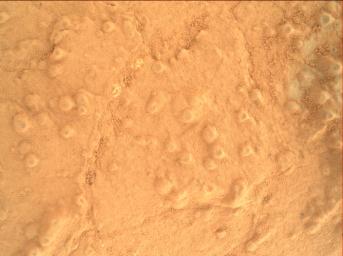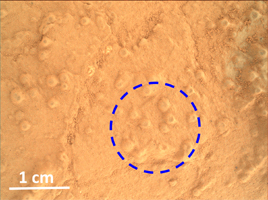
|
Concretions at ‘Cumberland’
- Click the image above for a larger view
- Full-Res JPEG (1608 x 1200) (309.1 kB)
- Full-Res TIFF (1608 x 1200) (5.8 MB)
Caption:

Annotated Image
Click on the image for larger version
This image taken by the Mars Hand Lens Imager (MAHLI) on NASA's Mars rover Curiosity shows the texture of the patch of flat-lying bedrock called "Cumberland," which was the mission's second target for use of the rover's sample-collecting drill. Cumberland was selected to be similar to the first, "John Klein," but with a slightly greater concentration of erosion-resistant granules that cause surface bumps. The bumps are concretions, or clumps of minerals that formed when water soaked the rock long ago. Analysis of a sample containing more material from these concretions could provide information about the variability within the rock layers of both drill targets, John Klein and Cumberland.
This image was taken on the 279th Martian day, or sol, of the mission (May 19, 2013) from a distance of 2 inches (5 centimeters).
Background Info:
Malin Space Science Systems, San Diego, developed, built and operates MAHLI. NASA's Jet Propulsion Laboratory, Pasadena, Calif., manages the Mars Science Laboratory Project and the mission's Curiosity rover for NASA's Science Mission Directorate in Washington. The rover was designed and assembled at JPL, a division of the California Institute of Technology in Pasadena.
More information about Curiosity is online at http://www.nasa.gov/msl and http://mars.jpl.nasa.gov/msl/ .
Cataloging Keywords:
| Name | Value | Additional Values |
|---|---|---|
| Target | Mars | |
| System | ||
| Target Type | Planet | |
| Mission | Mars Science Laboratory (MSL) | |
| Instrument Host | Curiosity Rover | |
| Host Type | Rover | |
| Instrument | Mars Hand Lens Imager (MAHLI) | |
| Detector | ||
| Extra Keywords | Color, Water | |
| Acquisition Date | ||
| Release Date | 2013-06-05 | |
| Date in Caption | 2013-05-19 | |
| Image Credit | NASA/JPL-Caltech/MSSS | |
| Source | photojournal.jpl.nasa.gov/catalog/PIA17066 | |
| Identifier | PIA17066 | |
